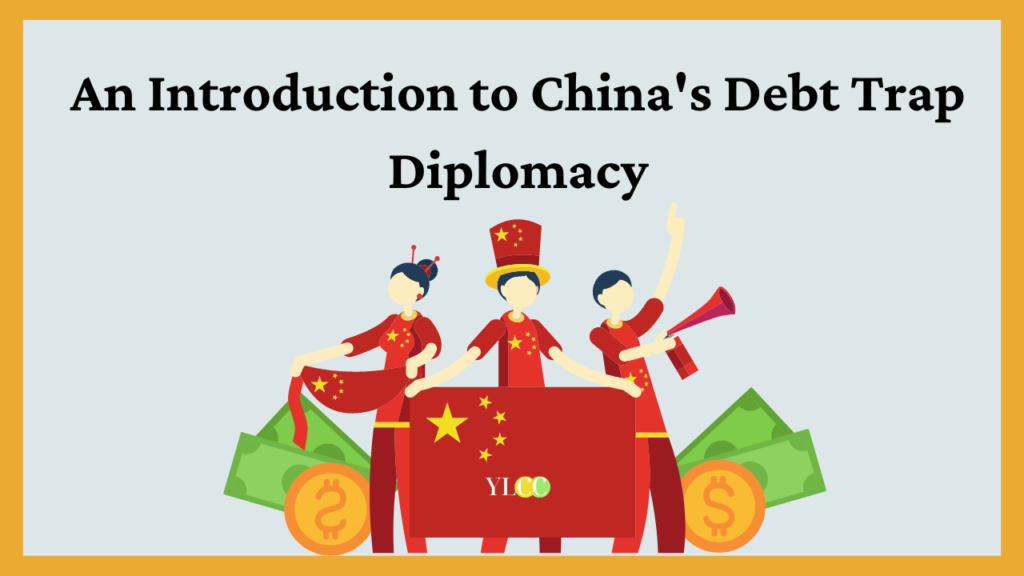
INTRODUCTION
Debt Trap diplomacy can be defined in simple terms as an international relationship, primarily financial in nature, in which a creditor country or a creditor institution extends to a borrowing country, a debt in order to either partially or slowly increase the lenders’ prestige and political privileges with respect to the relations between the lender and the borrower country. In such debts, the creditor country is said to extend unfair terms towards the borrowing country in order to leverage its powerful position vis-a-vis the borrower country, and the intention of issuing such debts is often to extract a myriad of economic advantages and political considerations, which the borrowing country would otherwise be unable to extend in normal terms. The conditions of such debts are often unfair, disproportionate, and not publicized. Furthermore, when the borrowing country is unable to meet its debt obligations, the lending country takes over vital assets and payments, which puts the borrowing country into a debt trap.
ORIGIN & EXTENT
Brahma Chellaney, an Indian Academician, is responsible for the coinage of the term ‘debt-trap diplomacy’. Chellaney coined the term in order to highlight what he construed as China’s predatory lending practices, which often burden poorer countries with disproportionate and unfair loans and debt obligations which they cannot fulfill Various economists also state that this is a part of China’s geostrategic dominance vision. It is often stated that in order to combat the problem of debt trap diplomacy, countries must shed away secret negotiations, as well aim for competitive pricing of goods and services, and such countries must seek the adherence to fair trade practices in order to sustain its national interests while trying to gain leverage from countries like China. Western African and Indian media has often criticized China with regards to the terms and conditions of extended loans by China with respect to high interest rates, unfair practices, and predatory norms. Further it is a matter of concern that countries turn to China instead of seeking leverage from institutions, such as the World Bank and International Monetary Fund.
COUNTRIES ENTRAPPED
Many countries have fallen in the trap of deep economic crisis, coupled with extreme financial loss, due to falling for ‘attractive’ loans, and concessions offered by China with respect to various national level and infrastructural projects. Sri Lanka is facing its worst economic crisis since the 1990s due to skyrocketing inflation and falling foreign exchange reserves and had to cede Hanbantota International port to China for a period of 99 years due to a failure to fulfill its obligations under the loan agreements granted by China.
Furthermore, Nepal too is in the throes of a deepening economic crisis and has banned the import of luxury items as well as vehicles due to its falling foreign exchange results after dealing with China. Around 40 countries have entered into various agreements with China, which include countries such as Krygyzstan, Laos, and Zambia. According to International Think-Tank and Research and Development Organization at the College of William and Mary in the state of Virginia named, AidData, the Belt and Road Initiative of China has left various low income and middle income countries reeling with economic debts to the tune of over $385 million. Furthermore, despite the unfair conditions leveled by China, no progress is made on the front of various infrastructure projects in lieu of which various low-income countries have put themselves into precarious and dangerous situation.
TERMS OF DEBTS EXTENDED
From the above discourse, it is clear how the loans from China differ significantly from those from other financial institutions such as the World Bank, International Monetary Fund, OECD, etc. While the former offer loans under hazy contracts, frequently with early termination and full repayment stipulations, the latter offer loans with legitimate, transparent terms and conditions. In general parlance, the terms must be clear and accessible to all party members, as financial institutions are intergovernmental organizations practice with nation-states as their constituents. Contrarily, Chinese loans, whether they are commercial or concessional, are provided by Chinese banks, leaving only China and the country borrowing the money as participants.
Furthermore, the Chinese banks are not responsible or answerable to anyone who is not directly involved in the contract as long as the conditions are understandable to the concerned parties, under loads which can be considered as future ‘debt-traps’. Further research revealed that none of the nations that have borrowed money from China have accused it of having unclear or disguised terms and conditions; rather, they have emphasized that Chinese loans have substantially higher interest rates. Since they have a poor credit standing in the global financial system, they have also expressed concern about the lack of alternatives. However, such countries find themselves trapped in the exigencies of repayment with little or no alternatives.
RECENT CONCERNS
When the COVID-19 pandemic started, Sri Lanka was already experiencing political and economic unrest, and also there was the ongoing crisis between Russia and Ukraine. In the International Arena, the Island Nation sought and solicited help. The Lankan government turned to China and obtained large development financing after both the US and India withdrew their support. However, this choice ended up being Sri Lanka’s worst error. The projects, financed with Chinese loans, did not generate enough revenue to support the economy and the fiscal deficit, causing the island nation’s debt to rise even faster and its foreign reserves to deplete. As a result, the Chinese business obtained a 99-year lease for the Lankan port of Hambantota. However, this purchase of the port’s controlling ownership was symbolic of China’s growing influence in the world arena, which has concerned both Asia and West alike.
WAY FORWARD
Even though the picture is contradictory, it is worrying. On the one hand, we cannot dismiss the existence of the “China Debt Trap” propaganda, which has grown into a potent tool in geopolitical strategy. China, on the other hand, is gradually expanding its influence over the world thanks to its carefully thought-out loans. However, the West must bear responsibility for the lack of any viable alternatives for the developing world. Instead of criticizing and urging other countries not to ask the Asian Giant for financial aid, the US should counter China by offering a “New International Financial Framework” where developed nations band together to aid underdeveloped and poorer nations.
CONCLUSION
In order to protect its strategic interests in the area and prevent China from shadowing its other boundaries, India is attempting to preserve its influence in the region and oppose the expanding debt-trap tactics of its eastern neighbour China through cooperation methods and humanitarian help. It is necessary to consider other funding sources for these connectivity projects. Professional Financial Institutions from the larger countries will be requested to offer assistance in these matters.
To provide countries with other connectivity options, India must cooperate with its regional allies. When assistance from allies such as Japan is required, India must develop an alternative to Chinese-led connectivity corridors and infrastructure projects. Thus, India must follow a collaborative and strategic approach in order to counter the growing influence of china in global geo-politics, and must seek support in order to reduce the dependence of poorer countries on China, by offering alternative sources of funding. In the long run, it is imperative that a viable solution has to be worked out in order to mitigate the ill-effects of the ‘debt-trap’ diplomacy that China has entrapped many nations in.
YLCC would like to thank its Content Team for their valuable insights in this article.






